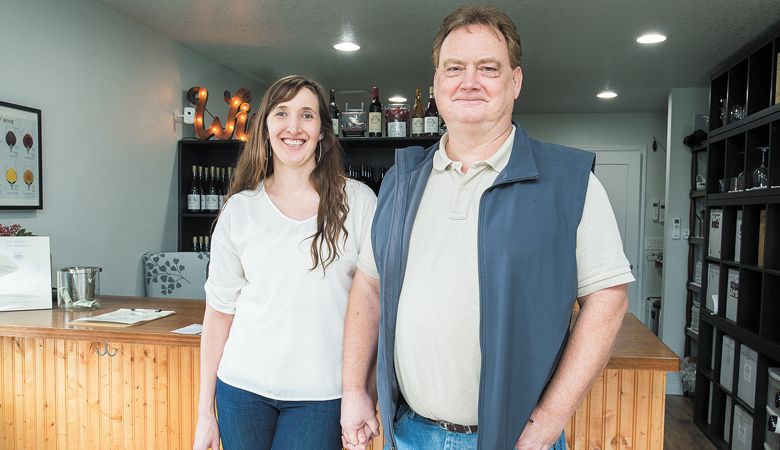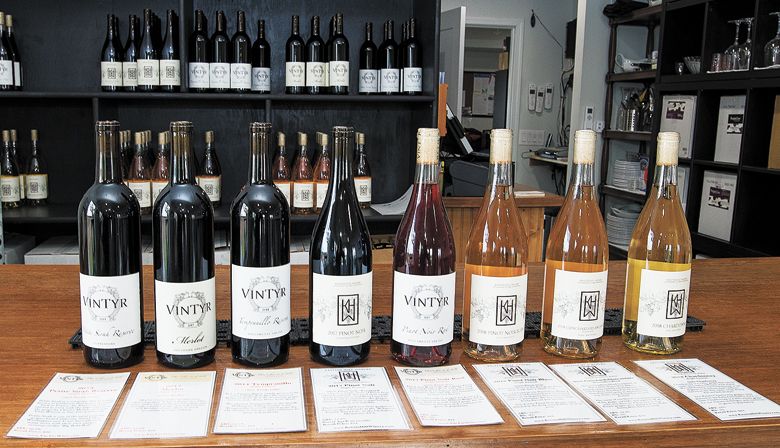Revitalizing Kristin Hill
Rasmussens bring new life to longtime Eola-Amity Hills winery
Dave and Briana Rasmussen are those rare people for whom counter-intuition is an art form. In fact, she recalls a time — encouraged by high spirits at a local tavern — she advised Oregon wine pioneers Dick Erath and Dick Ponzi some ways to improve their Pinot Noir. “I just marched right into that,” Briana says.
Dave is no wallflower, either.
“I wake up,” he says, “and all I want to look forward to is making wine.” Briana, seated close by, nudges Dave as if to assent. The couple says this is definitely not American Gothic — with the stone-faced farmer, plain-dressed wife and pointed pitchfork. Rather, their venture in vines has been a much more colorful journey.
The dynamic duo of Vintyr — a label dedicated to big reds — has been busy with Kristin Hill, their newly acquired Amity estate, founded by Eric and Linda Aberg and sold to the Rasmussens in December 2017.
When approaching the purchase, Dave and Briana took into account its history, the vines, the outbuildings, its proximity and, well, the properties of the property. They also knew they’d need to focus on restoration to make it their own, with an end goal of achieving a production of 10,000 cases.
Even ahead of these considerations, the pair possesses the gift of practical magic, an instinct for research and experimentation not strangled by preconceptions, ego or a need to pay the mortgage.
The search for the perfect site took several years — meanwhile Vintyr was being crafted in an industrial space off Newberg’s main drag and sampled in a nearby tasting room. The Rasmussens first heard about the property’s availability through the Oregon Department of Agriculture in the spring of 2017. Knowing their previous experience in development and construction, and ownership of an existing winery, an official alerted them about Kristin Hill’s listing.
The vineyard’s location compelled the couple. It sits at the junction of Highway 99W and Highway 233, a crossroads, of sorts, that leads to a number of AVAs, including its Eola-Amity Hills home. In other words, if you’re driving past Dundee Hills toward the coast, Kristin Hill is on your way.
The winery facility was also a plus. “It was in great shape; it just needed a little cleaning, weeding and love,” Dave explains. “The rest of the property of 19 acres of grapes and buildings needed a lot of care due to a few years of wonderful people unable to maintain this site. Most people looked at the property and said, ‘Bulldoze it and start from scratch.’ With our backgrounds, we were able to see something different than the average person.”
They were perfectly suited to take over what the former owners started long ago. The Abergs were retired military commanders with a long assignment in West Germany, near the terraced vines of the Mosel and Rhine. They loved German varietals and, though Tar Heels by origin, wanted to replicate the familiar surroundings near Wiesbaden at a location in the U.S. Kristin Hill appealed about as much as a red convertible to a pair making a road movie. They didn’t even notice the outbuildings — never kicked the tires. It was their “Field of Dreams,” so to speak — and, yes, it was the ’80s.
Rasmussen recalls of Eric Aberg: “He loved the prospective vineyard site for slopes, soil and terrain so much he forgot to look at the inside of the houses and buildings. The farmer was so surprised at his lack of concern, he stopped Eric from leaving before they made the deal, to make sure he knew what he was getting with the buildings — I love that story.”
The Abergs were excited about the perfect vineyard site, not the structures, which includes a 1910 farmhouse — the Rasmussens will revitalize this main dwelling last.
Work on the property has been intense. The new owners say they faced a “hand machete nightmare” at first, but preserving the history and the Abergs’ own hard work has kept them on track. Restoration is what stewards of the land do.
While visitors will admire the new setting, most will likely be unaware of the grunts, oaths and sweat that get edited from our purview, including the clearing of raging invasive greenery from the stand of oaks by the entrance. And then there were the vines.
“We infilled missing plants, evaluated trunk health and re-trunked plants where needed,” Dave says. “This started with the four blocks planted in the mid-’90s. We cut four blocks down to the ground and regrew new trunks from the roots up. We were a little more selective in the older fields and cut back some but not all the plants.”
On the trunks not fully cut, the Rasmussens selected the healthiest suckers and grew them as new plants. Dave explains, “In that way, we were still able to harvest grapes while working to replace the older plants.”
To replace the missing plants, they did two things: “First, we took cuttings from the plants adjacent and started growing new plants in the greenhouse. Second, later in the year, we bent canes from the adjacent plants down from the canopy and planted the tips into the ground; this is the fastest and most guaranteed way to start a new plant. The cane continues to receive nutrients from the plant but also starts to create roots of its own. This does lower the grape yield a little but has allowed us to infill all the older and mature vines that are part of the appeal we knew to be waiting for a kind of resurrection.”
Rasmussen ticks off the mature plantings that make the property distinct — as if he were naming his hunting dogs. The Abergs planted in stages: 1985: Gewürztraminer; 1986: Chardonnay (Dijon) and Pinot Noir (Pommard and Wädenswil); 1990: Chardonnay (UC Davis 108); 1992: Pinot Noir (Pommard and Wädenswil); 1994: Pinot Gris; 1995: Pinot Noir (Pommard and Wädenswil); 1997: Chardonnay (Dijon); and 2018: Marechal Foch.
The Abergs remain close to the Rasmussens; Briana says a case of wine heads east to the founders’ new home each holiday as a tribute, to keep connected. After all, this is one of the early Amity producers, despite its hiatus.
At the new Kristin Hill, the overall vibe centers on Dave and Briana and their strong relationship. He says, “We both grew up wanting a partner in life and failed miserably at finding one for ourselves until we both ran face-first into each other. Don’t get me wrong, we can be stubborn and know-it-alls at times, but when the chips are down, we have each other’s backs. We defiantly know what we don’t want out of life.”
They also know what they DO want; the two have distinct palates and attitudes that will be driving Kristin Hill’s new wines.
Dave says, “Briana spent a year studying in Germany in college, and while there, fell in love with the bright, acidic, aromatic white wines. This property allows us to make those wines with our own spin on them.” On the other hand, “Italian and southern France reds let me die with a bottle of each in hand with my wife next to me whispering in my ear.”
They can put their heads together as needed, of course; they need not even leave the tasting room, the building closest to the highway junction. Briana suggested and implemented a winery suite to accommodate overnight visitors interested in touring the region from inside a working vineyard. The space adds to Kristin Hill’s new vision.
So much work has been accomplished already, and yet, as with any farm, the work is never done. The Rasmussens know that and are ready for whatever comes next.
















